Redness of the skin around the nose is a common symptom that signals the manifestation of a serious pathology. Perhaps this is a normal physiological reaction of the body. Discoloration around the nose brings discomfort and discomfort to a person. What is the reason for such external changes, when do you need to see a doctor? Let's talk in more detail about the causes, possible diseases and treatment methods.
Causes and etiology
Redness around the nose: the causes usually correspond to dermatological diseases of the skin. In medical practice, women most often suffer from changes in skin color in this part of the face. At risk are teenagers during puberty and women who abuse the use of cosmetics.
Pathological condition of the epidermis: peeling in the nasolabial part of the face, redness caused by a number of negative factors. It is necessary to analyze each possible case in more detail.
Rosacea: symptoms
Rosacea is a long-term reddened condition of the facial skin. Additional signs: superficial vasodilatation, papules, pustules and swelling. Symptoms characterizing this disease:
- facial hyperemia – increased blood flow. A person may feel sudden rushes of blood (short and fast). The skin on the face turns pink, there is a feeling of warmth on it;
- redness on the nose, its sides and partly on the cheeks;
- the nose swells;
- red large pimples;
- cystic acne may appear;
- oily skin on the forehead;
- dryness, itching in the eyes - in some cases.
The appearance of acne is often caused by hyperemia. It is this disease that aggravates rosacea and turns the problem into a chronic one. First, the tip of the nose acquires a reddish tint, and the pigmentation spreads to the bridge of the nose. As soft tissue grows, the nose becomes slightly enlarged and deformed. This disease is most often diagnosed in women who are postmenopausal.
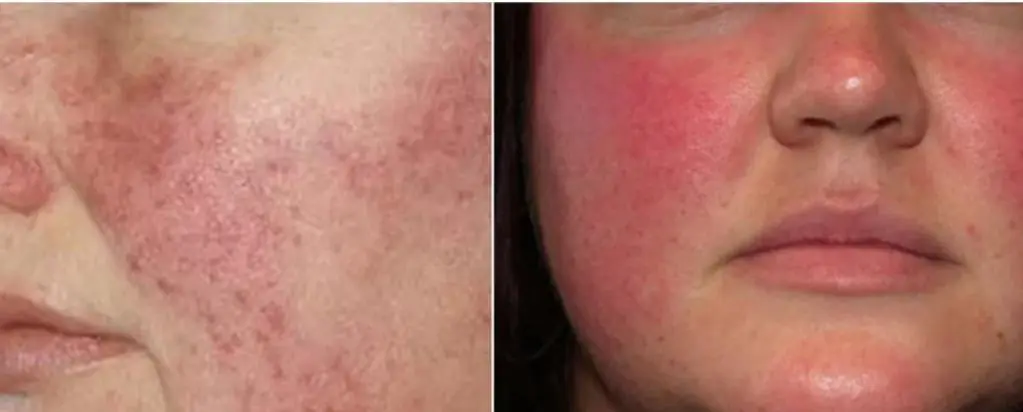
Negative factors that provoke this condition:
- eating spicy food;
- alcohol abuse;
- face mite infestation;
- intestinal infections.
Rosacea is not dangerous, but it brings aesthetic and psychological discomfort.
Perioral dermatitis
Redness of the skin around the nose and under the eyes in the form of red pimples and peeling are symptoms of perioral dermatitis. This disease manifests itself in the form of eczema. It mainly affects the mouth and lips area. Among the causes of occurrence are the following:
- long-term use of nasal sprays, creams containing topical steroids;
- the use of cosmetics based on petroleum jelly or paraffin;
- certain types of toothpastes;
- bacterial and fungal infections.
Symptoms of perioral dermatitis:
- a red rash on the sides of the nose, in the folds under the nose and eyes, also on the chin and forehead;
- in severe cases, the rash manifests itself in the form of peeling on inflamed areas of the skin;
- burning and constant itching.
The disease can appear at any age, regardless of gender and race. Young women and teenagers are most often affected.
Experts in the field of dermatology say that recurrence of perioral dermatitis can cause chronic rosacea.
Seborrheic dermatitis
Redness and flaking of the facial skin around the nose are sure symptomatic signs of seborrheic dermatitis. The disease manifests itself on the face, around the nose, around the eyes, on the forehead and affects the scalp. Seborrheic dermatitis is a chronic disease, but is not transmitted.
Seborrheic dermatitis is caused by yeast-like fungi. This is a disease of the sebaceous glands. Thus, when exposed to chemical, physical, mechanical and thermal irritants, with a decrease in immunity, the activation of fungi is provoked. They multiply and appear in significant numbers. The skin on the nose turns red and becomes covered with peculiar ulcers.
Demodicosis
This is a fairly rare dermatological disease. Demodectic mange is caused by a subcutaneous parasitic mite. Experts believe that 97% of the inhabitants of planet Earth have such microorganisms. However, their manifestation is caused by decreased immunity, a severe emotional state and great stress experienced.
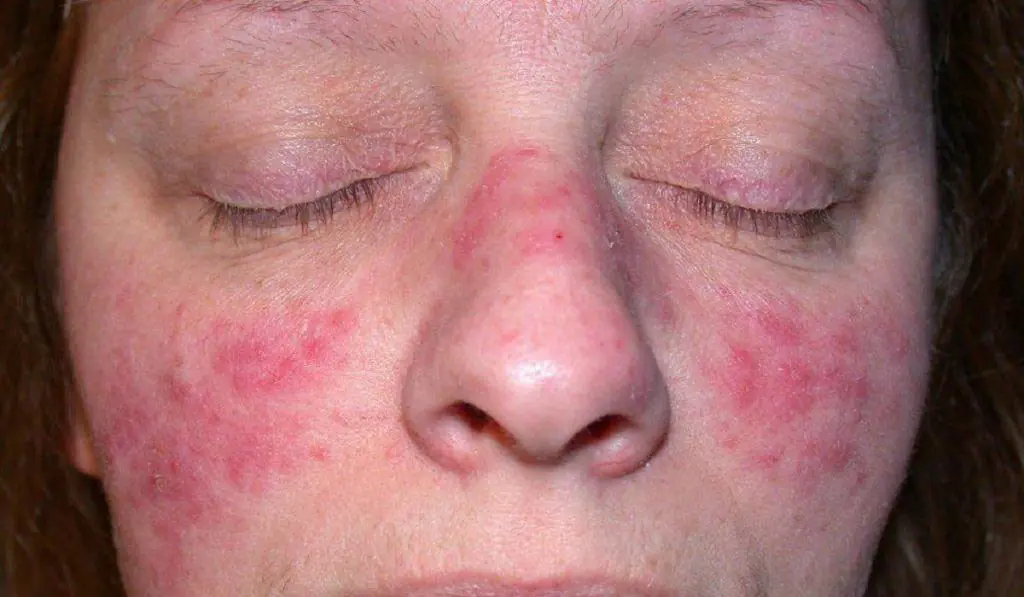
Demodicosis occurs in pregnant women and those who suffer from hormonal diseases. Without special equipment, it is impossible to identify the subcutaneous parasite.
Cuperosis
This is a serious disease of vascular-cutaneous pathology. As a result of the pathological process, the vascular walls become less elastic and thin. Spider veins appear on the nose of patients.
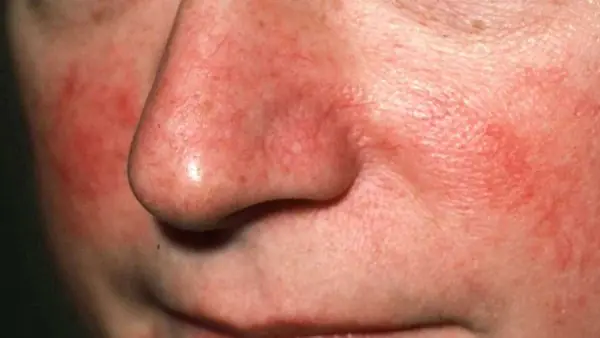
Cuperosis is not a cosmetic problem, but a serious illness. When the capillary walls are weakened, paralysis of muscle fibers occurs.
Allergic reaction
Dust, mites, seasonal flowering of certain plants, animal hair, cosmetics are the reasons that cause redness of the facial skin around the nose. This is all an allergic reaction of the human body to external irritants.
The mucous part becomes inflamed due to hyperemia (dilation of the capillaries), and severe swelling of the skin occurs. Redness of the nose is one of the symptoms.
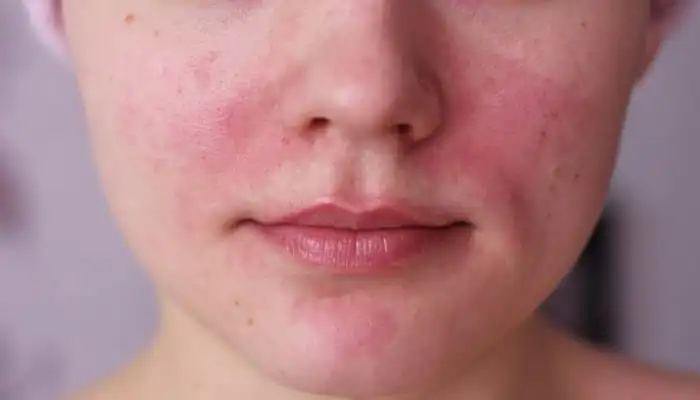
Frequent use of a handkerchief can cause skin irritation.
Lupus pernio: what kind of disease, symptoms and causes
Redness on the face around the nose is a form of manifestation of lupus pernio. This is a form of cutaneous sarcoidosis. The color change occurs due to an increase in the vascular network. The color of the redness can vary from a reddish tint to purple. Changes in skin color can affect not only the nose area, but also the cheeks, lips and ears. At the same time, the skin in the inflamed areas shines and swells.
The disease most often affects women between 45 and 65 years of age.
Symptoms of lupus pernio are not clearly visible. There may be slight itching or pain when pressed. Cosmetic external disfigurement is a common complaint. The cause of the disease is still unclear.
Systemic lupus erythematosus
Lupus is an autoimmune disease. In this disease, the immune system mistakenly attacks healthy tissue.
Symptomatic manifestations of the disease can begin in adolescence and up to 30 years.
Redness around the nose, fatigue, fever, dry mouth, and joint problems are common symptoms of lupus.
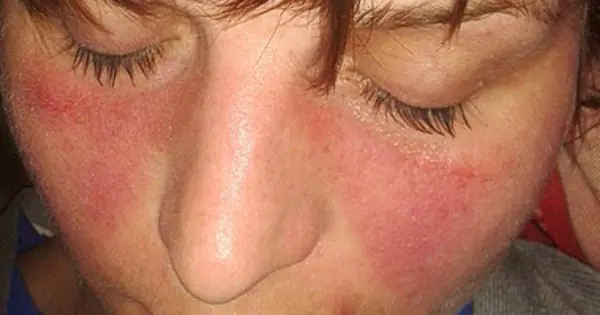
The skin rash on the face resembles the shape of a butterfly. This is why it is popularly called “butterfly rash.” However, a rash is not always characteristic of the manifestation of this disease.
CPAP mask
People suffering from acne or sleep apnea often resort to using a CPAP mask. This is special equipment. Due to the strong tension of the belts, redness around the nose occurs almost immediately. Using this mask may cause serious inflammatory skin disease. Ulcers may appear on the skin of the face.
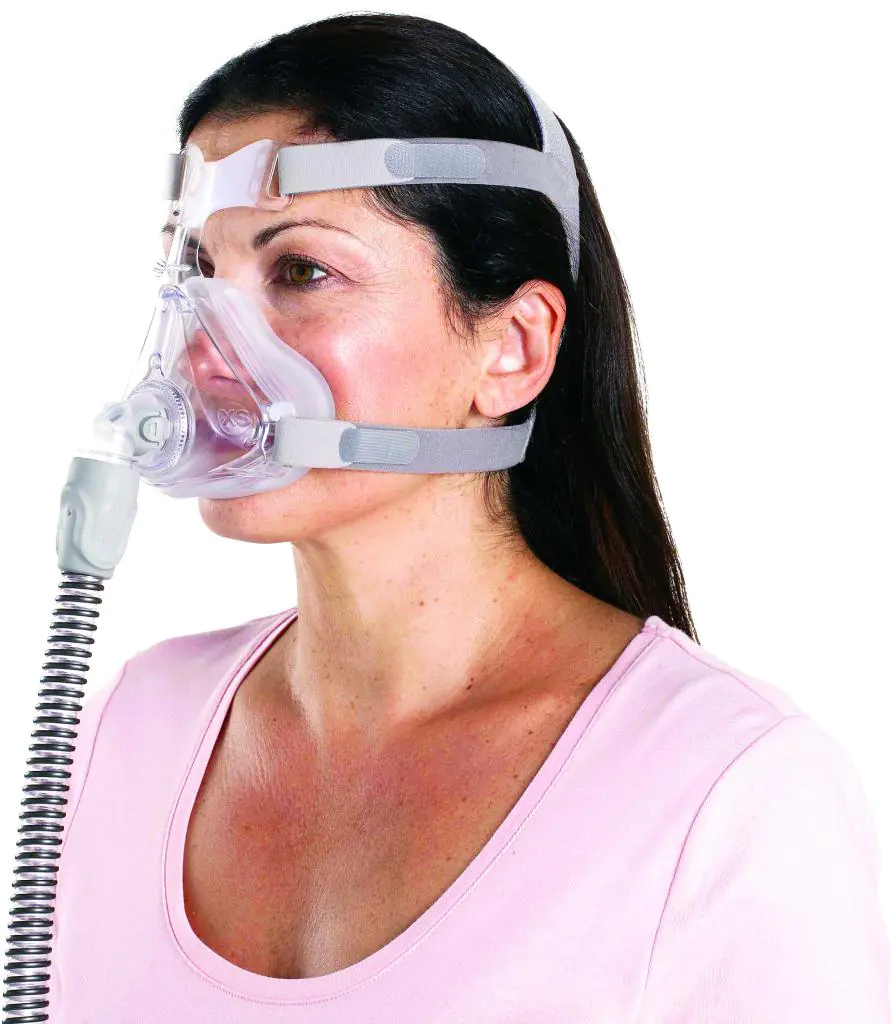
Solution to the problem: choose an alternative method of acne treatment.
Other reasons
Other reasons can cause redness and peeling of the skin around the nose:
- abuse of drugs that affect the cardiovascular system;
- ARVI is a respiratory infection of viral origin, acute rhinitis is a clear symptom;
- rhinophyma - benign tumor-like skin lesion;
- acne vulgaris, a manifestation of hormonal imbalance, chronic endocrine pathology and improper facial skin care;
- avitaminosis;
- psychoneurological abnormalities - stressful situations, anxiety contribute to the dilation of blood vessels on the skin of the face, blood microcirculation is disrupted;
- formation of subcutaneous acne;
- single pimples;
- cuts or scratches;
- burns;
- long walks in the cold.
If you detect the first external manifestations of redness on the nose, you should urgently consult a doctor. Timely diagnosis of the disease will help you quickly begin proper treatment.
When to see a doctor?
Redness around the nose is a symptom of various pathologies. If your nose remains red for a long time, you should consult a dermatologist. Diagnosis of the disease includes a general blood and urine test, biochemical blood test and others.
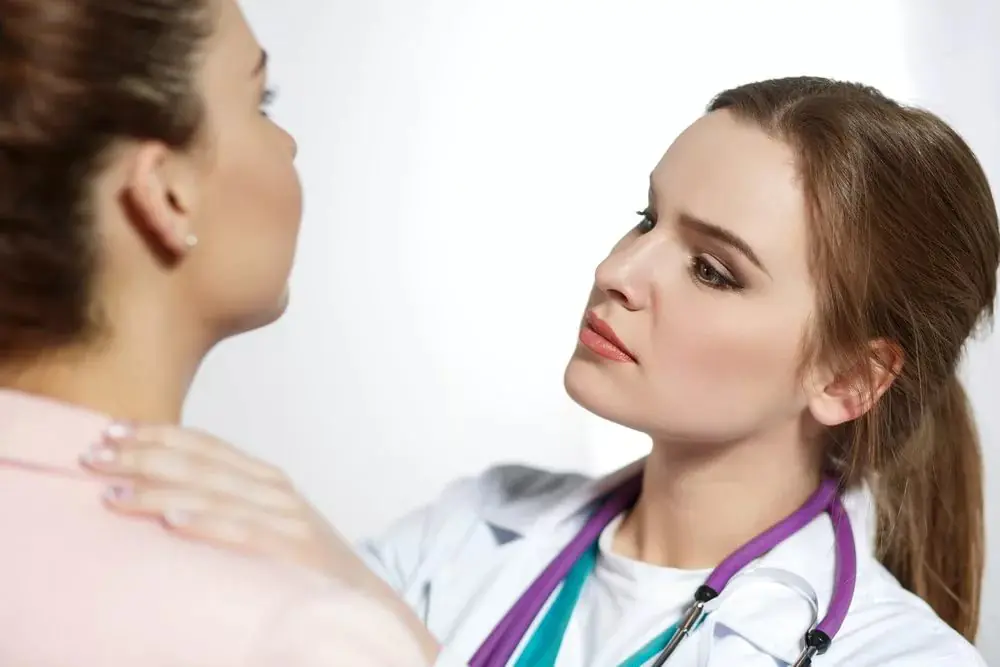
Additional symptoms should cause severe anxiety in a person:
- chills, deterioration of health, fever;
- purulent discharge on the nose;
- the appearance of painless formations on the walls, back and wings of the nose;
- the skin on the nose thickens, and the nose visually increases in size.
You should not prescribe treatment on your own. You should immediately consult a doctor without neglecting the symptoms.
Treatment
Redness around the nose is a manifestation of pathologies. Timely diagnosis and proper treatment are necessary. Traditional medicine includes the following drugs:
- to strengthen the walls of blood vessels, normalize blood pressure - tablets "Antistax", "Ascorutin", "Detralex";
- vitamin therapy to improve metabolic processes in the body: vitamins C, P and K;
- restoration of the immune system with the help of immunomodulators: “Immunal”, “Bronchomunal”, “Likopid”;
- special ointments containing antibiotics;
- physiotherapy;
- laser therapy, surgery for rhinophyma;
- antihistamines “Suprastin”, “Tavegil”;
- for respiratory infections, antiviral drugs are prescribed: Kagocel, Cycloferon;
- antibacterial and anti-inflammatory treatment (for seborrheic dermatitis and rosacea).
Systemic lupus erythematosus is treated only by rheumatologists. Patients are prescribed hormone therapy.
Natural Treatments
You can resort to traditional medicine only after consulting your doctor. If the doctor has not detected a serious pathology, then traditional methods of treatment can be used.
- A mask of lemon, honey and fresh parsley is an excellent remedy for redness around the nose and flaking. Parsley needs to be chopped and mixed with lemon juice and honey. Apply the mixture to your nose for 5 minutes.
- Every morning, treat your nose with an ice cube of chamomile infusion.
- Wipe the skin of the nose with hoofweed infusion.
- Fresh apple mask: grate an apple, add lemon juice. Apply the resulting product to your nose.
- Soak gauze in rosehip broth and place it on your nose.
Redness around the nose, peeling - external defects on the face. They should not be ignored. People suffering from this defect become irritable. Gradually, they may develop an inferiority complex. And this is already a psychological problem.
If the first symptoms appear, consult a doctor immediately. Perhaps pathology is already actively developing in your body. Self-medication is an ineffective way to deal with redness. The key to your health is timely traditional treatment. Your health is in your hands!
Good afternoon Since 2015, I have had a red spot on the bridge of my nose, near my left eye. It feels like skin renewal. I've been on treatment for 4 years now (Pimofukort, Comfo-Derm, Elidel, Flucinar), it seems to be starting to lighten, then it turns red again. I saw an oncologist and was diagnosed with basilioma, the result was negative. Now a dermatologist is diagnosing benign lymphoplasia of the skin. Appointment - elidel. I applied it for 2 weeks, it became a little pale, now it’s red again. Tell me what to do? Where to go, what to do? Maybe I need to try something with a laser?
The Ask a Doctor service offers an online consultation with a dermatologist on any problem that concerns you. Expert doctors provide consultations around the clock and free of charge. Ask your question and get an answer immediately!
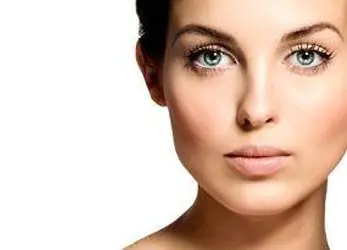
1. Rectum. On the face it is represented by a projection zone on the surface of the skin of the upper left forehead. Functional impairment can manifest itself as skin pigmentation, acne, redness, and the growth of moles.
2. Sigmoid colon. Its representation is located on the surface of the skin of the left upper lateral area of the forehead. Functional impairment may manifest as skin pigmentation, pimples, redness, and moles.
3. Liver. The representation is located between the eyebrows, in the space between the base of the bridge of the nose and the line connecting the brow ridges on the skin of the forehead. Liver pathology is accompanied by skin irritation, acne, pigmentation, and moles.
4. Small intestine. Its projection is located in the middle part of the forehead, and with intestinal pathology it is manifested by skin disorders (pigments, pimples, redness).
5. Descending part of the colon. Its representation is located on the left lateral surface of the skin of the forehead. Functional disorders manifest themselves on the skin (pigmentation, dryness of the area, increased porosity, acne).
6. Left adrenal gland. The projection is located in the medial superciliary region of the left half of the face. With a functional disorder of the adrenal gland, pain in the periosteum of the superciliary region appears, and the skin reacts with irritation.
7. Area of the left kidney pelvis. It is projected onto the skin of the inner surface of the corner of the left eye and the tear duct. The pathological process in the area of the renal pelvis is sometimes expressed by a skin reaction in this area (darkening, pigmentation, redness, enlarged pores, growth of papillomas, wen). Sometimes the problem contributes to the formation of a blockage of the tear duct, an inflammatory process in it, and excessive lacrimation.
8. Upper pole of the left kidney. It is projected onto the brow ridge and the skin of the upper part of the eyelid. The disorder is manifested by a vascular pattern (swelling), pimples, redness, and porosity on the skin.
9. Left lobe of the liver. Projected onto the white membrane of the eye. A disorder in the liver is manifested by a red vascular pattern on the white of the eye.
10. Body of the gallbladder, spleen. The projection is located on the skin and on the periosteum of the temporal bone on the left side of the face. With bladder pathology, redness, pimples, pigment spots appear on the skin, its porosity and venous pattern increase. The periosteum of the temporal bone also reacts; it becomes painful upon palpation.
11. Left part of the transverse colon. The representation is located in the lower medial part of the corner of the left eye. Its dysfunction is manifested by bulging of the skin from the inner corner of the eye under the lower eyelid to the outside of the face, sometimes with redness or pigmentation.
12. Pancreas. Its representation is located on the lower part of the bridge of the nose, at the border of the connection with the tip of the nose. The pathology is manifested by skin irritation, pigmentation, and sometimes a venous vascular pattern.
13. Biliary ducts of the liver and gallbladder. The projection is located in the lower part of the temporal bone of the left half of the face. With their pathology, redness, pigmentation, pimples and a vascular pattern are observed on the skin, with long-term pathology - porosity. The periosteum of the temporal region becomes painful. Often the pathology is accompanied by headaches of temporal localization. Additionally, it can be noted that sometimes when the bile ducts are blocked, the skin of this area of the face turns yellow.
14. Left kidney. The projection is represented by the left auricle (skin and cartilaginous base). The auditory canal is a projection of the ureter, the inner ear is a projection of the bladder. In pathological conditions of the kidney, hearing decreases, inflammation of the inner ear occurs, and vestibular disorders appear. In some cases, hardening of the cartilage base is observed. Sometimes it softens, and sulfur secretion from the ear canal increases.
15. Cardiac pathologies. The projection is presented in the upper left part of the left cheek at the junction with the orbit. Pathologies are expressed by swelling of the skin, redness, pigmentation, and a vascular pattern in the infraorbital region.
16. Ureter of the left kidney. It is projected onto the skin of the face by a line running from the corner of the eye along the cheek to the bottom of the chin. When it is irritated by sand, small stones or when there is inflammation in it, a pattern of a line or part of a line of white or red color appears on the skin (depending on which part of the autonomic nervous system prevails - sympathetic or parasympathetic).
17. Left lobe of the liver. Its representation is located on the left side of the face, in the area of the muscles of the jaw joint. It manifests itself as an involuntary increased tone of the muscle group, the development of arthrosis of the joint. Occasionally, the disorder is projected onto the skin in the form of pigment or irritation.
18. Left mammary gland. The projection is located on the skin of the left cheek at the intersection of a vertical line coming from the outer part of the corner of the eye and a horizontal line passing through the upper pole of the wings of the nose. The diameter of the projection of the mammary gland on the cheek will be approximately equal to the distance from the corner of the eye to its iris. The pathology is manifested by pigmentation, redness, increased porosity, and swelling of the skin.
19. Left lung. It is projected onto the skin of the left cheek, covering the cheekbone. The pathology may manifest itself as redness, angiopathic pattern, porosity, pigmentation, pimples, dryness, unevenness or roughness of the skin surface.
20. Heart disorders (more often - rhythm disturbance). They are projected on the skin of the tip of the nose in the form of redness, angiopathy, and pimples.
21. Bronchus of the left lung. Projected on the skin of the wing of the left half of the nose. Violations are expressed by a vascular pattern, redness, pimples, and pigmentation.
22. Diaphragm, costal arch. They are projected on the skin along the nasolabial fold. Violations are manifested by redness of the fold, dry skin in it.
23. Lesser curvature of the stomach. Projected onto the skin and mucous membrane of the upper lip. The pathology is manifested by transverse cracks on the lip, herpetic eruptions, peeling of the skin, loss of lip color, and the appearance of lip wrinkling.
24. Duodenal bulb, pyloric section of the stomach.The projection zone is located on the skin outside the corner of the mouth. Disturbances are manifested by pigmentation, redness of the skin, jams and cracks in the corners of the mouth, and in degenerative processes - the growth of moles.
25. Adrenal gland of the left kidney. It is projected onto the skin and muscles of the upper compartment on the left lateral axillary line, as well as to the left and right of it along the muscular lateral surface. The pathology is manifested by muscle pain upon palpation; on the skin it sometimes manifests itself as irritation, pigmentation, and papillomomatosis.
26. Left inguinal fold and area of the pupart ligament. The projection is located on the left outer surface of the skin of the chin. Violations are manifested by redness of the skin, acne, age spots.
27. Left ovary in women, left testicle in men. The representation is located on the skin of the chin on the left side, near the left mental fold. The pathology is manifested by redness of the skin, pimples, dryness and flaking of the skin, and the growth of moles during degenerative processes.
28. Left mammary gland. It is projected on the chin on the left side under the lower lip on the bony tuberosity. The pathology is manifested by increased pain sensitivity, redness, pigmentation or pimples on the skin, growing moles.
29. Pubic symphysis. Its representation on the face is on the chin, in the mental fossa. The pathology is manifested by soreness of the periosteum of the chin upon palpation examination.
30. Left kidney. It is projected onto the skin and muscles of the lateral surface of the neck (along the left lateral axel line), as well as to the left and right of it along the muscular surface. The pathology manifests itself as muscle pain upon palpation. Pigmentation, redness appear on the skin, and papillomas grow.
31. Greater curvature of the stomach. The projection is the sternocleidomastoid muscle on the left side of the head. The disorder is manifested by increased tone and pain on palpation. The place of attachment of the muscle to the skull is projected onto the upper part of the stomach and the esophagus entering into it. The place of attachment to the clavicle is the projection of the pylorus.
32. Left appendage with ovary, left lobe of prostate gland with testicle.Projected on the upper third of the carotid artery on the left. It manifests itself as swelling and pain, enlarged lymph nodes in this area.
33. Bladder. Projected onto the skin from the chin to the epiglottis of the neck. Dysfunction is manifested by redness, pigmentation, growth of moles or pimples on the skin.
34. Pelvis of the left kidney. The projection is located on the left side of the neck, on the muscles of the lateral surface towards the base of the neck (along the lateral axelline). It manifests itself as pain upon palpation with irradiation to different parts of the body and head, on the skin - papillomas (infection of the pelvis), dryness, roughness.
35. Pancreas. The representation is located at the base of the neck on the left side, between the collarbone and the sternocleidomastoid muscle. It manifests itself during palpation examination as muscle pain, radiating to the shoulder, arm, scapula, hand, fingers, breast area, and sometimes to the pancreas area.
36. Left lobe of the thyroid gland. It is projected onto the lower part of the neck along the esophagus, into the supraclavicular region and the region of the jugular notch. It is manifested by muscle soreness of these areas, tissue swelling, the skin is manifested by an angiopathic pattern (redness), papillomas.
37. Left ureter. The representation is located on the left side of the neck along the lateral axelar line from the projection of the pelvis of the left kidney to the shoulder joint. In pathological conditions, upon palpation examination, the muscle projection is painful. On the skin, the disorder manifests itself as pigment spots, papillomas;
38. and 41. Pyloric section of the stomach. It is projected onto the area of attachment of the sternocleidomastoid muscle to the clavicle. The pathology is manifested by pain in the attachment area.
39. Uterus, prostate lobes, perineum. The representation is located in the central lower part of the chin. The disorder is manifested by soreness of the periosteum upon palpation, on the skin - redness, pigmentation, pimples, and in degenerative processes in organs it is characterized by the growth of moles.
40. Right mammary gland. It is projected on the chin on the right side under the lower lip on the bony tuberosity. It manifests itself as increased pain sensitivity, on the skin above it is expressed by redness, pimples, pigmentation, moles during degenerative processes.
41. and 38. Pyloric section of the stomach. The projection is located on the right at the base of the neck in the area of attachment of the sternocleidomastoid muscle to the collarbone. With functional disorders of the department and during palpation examination, the projection is painful.
42. Right ureter. The representation is located on the right side of the neck along the lateral axelar line, from the projection of the pelvis of the left kidney to the shoulder joint. In pathological conditions of the ureter and during palpation examination, the muscular projection is painful; on the skin, the disorder manifests itself as pigment spots and papillomas.
43. Gallbladder. The projection is located on the right side of the base of the neck, in the area of the angle formed by the sternocleidomastoid muscle and the right clavicle. Depending on the pathological state of the bladder, when pressure is applied to its projection zone, pain irradiates to the right temporal region of the head, right shoulder, arm and fingers of this hand, scapula, chest, face, teeth, thyroid gland, skin of the neck, body of the gallbladder.
44. Right lobe of the thyroid gland. It is projected onto the lower third of the neck in the supraclavicular region on the right side along the esophagus. It manifests itself as muscle soreness in this area, tissue swelling. In pathological conditions of the gland, the skin in this place is manifested by porosity, redness, and papillomas.
45. Pelvis of the right kidney. The projection is located on the right side, on the muscles of the lateral surface of the base of the neck, along the lateral axel line. With pathology of the renal pelvis, pain occurs during palpation of the muscles with irradiation to different parts of the body and head. On the skin, the disorder is manifested by papillomas (infection of the pelvis), dryness, roughness, and moles.
46. Gynecology, right appendage with ovary, right lobe of the prostate gland with testicle. Projected on the upper third of the carotid artery on the right. The disorder is manifested by swelling and pain of the artery, and enlargement of the lymph nodes in this area.
47. Lesser curvature of the stomach. The projection is the sternocleidomastoid muscle on the left side of the neck. The upper part of the stomach and the esophagus entering the stomach are projected to the place of attachment of the muscle to the skull, and the pylorus of the stomach is projected to the place of attachment of the muscle to the clavicle. Indigestion is manifested by increased muscle tone and pain on palpation.
48. Right kidney. It is projected on the right side of the neck, on the muscles located on the lateral axelline. Pathology in the kidney manifests itself as pain upon palpation of the lateral muscular surface, sometimes radiating to various areas of the head, arm and upper shoulder girdle, and neck. With deep pathology, during pressure, irradiation goes to the right kidney. On the skin, disorders are expressed by papillomomatosis, redness, dryness and roughness.
49. The right ovary in women, the right testicle in men. The representation is located on the skin of the chin on the right side, near the right mental fold. The pathology is manifested by redness, dryness and flaking of the skin, acne, and the growth of moles during degenerative processes.
50. Lymphatic system of the iliac region. On the face, the iliac region (inguinal fold) is projected as a fold running onto the lower jaw from the corners of the mouth as a continuation of the nasolabial fold. With pathological processes in the groin, the problem can manifest itself as skin irritation, pigmentation, and acne.
51. Adrenal gland of the right kidney. It is projected on the skin and muscles of the upper neck on the right, on the lateral axillary line, as well as in front and behind it along the muscle surface. With a functional disorder, muscle pain sensitivity is present, sometimes radiating to various areas of the head and neck. The skin reacts with irritation and the growth of papillomas.
52. Small intestine. The representation is located under the base of the lower lip. In pathology, it manifests itself on the skin as irritation, pigmentation, and the growth of moles.
53. Greater curvature of the stomach. Projected onto the skin and mucous membrane of the lower lip. The disorder is manifested by cracks, herpetic eruptions, peeling, loss of color, and the appearance of the lip wrinkling effect.
54. Hormonal system. The projection area is the space on the face between the nose and upper lip. When the system is disrupted, acne, irritation, pigmentation appear on the skin, and hair growth occurs.
55. Signs of scleroderma. The skin becomes deeply wrinkled. Sometimes hair growth is observed (in women).
56. Small intestine. The projection is located in the lower part of the cheek under the cheekbone of the face. Disturbances in the small intestine result in skin irritation, pimples, unevenness or roughness.
57. Xiphoid process. The projection is located under the base of the nose. When it is injured or a pathological condition occurs, increased pain sensitivity, pimples, and redness appear at the base of the nose.
58. Greater curvature of the stomach. The projection area is the inner area of the left nostril. In case of indigestion, the nasal mucosa reacts with the formation of inflammation, swelling, and herpetic eruptions.
59. Lesser curvature of the stomach. The projection area is the inner area of the right nostril. In case of indigestion, the nasal mucosa reacts with the formation of inflammation, swelling, and herpetic eruptions.
60. Bladder, ureter of the right kidney. Projected onto the ear canal and inner ear. During inflammatory processes in the organs, pain appears in the ear canal, sometimes inflammation occurs, increased sulfur secretion occurs, and hearing decreases.
61. Bronchius of the right lung. Projected on the skin of the wing of the right half of the nose. Violations are expressed by a vascular pattern at the base of the wing of the nose, redness, and pigmentation.
62. Right mammary gland. The projection is located on the skin of the right cheek at the intersection of a vertical line coming from the outer part of the corner of the eye and a horizontal line passing through the upper pole of the wings of the nose. The problem is manifested by redness, pigmentation, acne, growth of moles, and skin swelling.
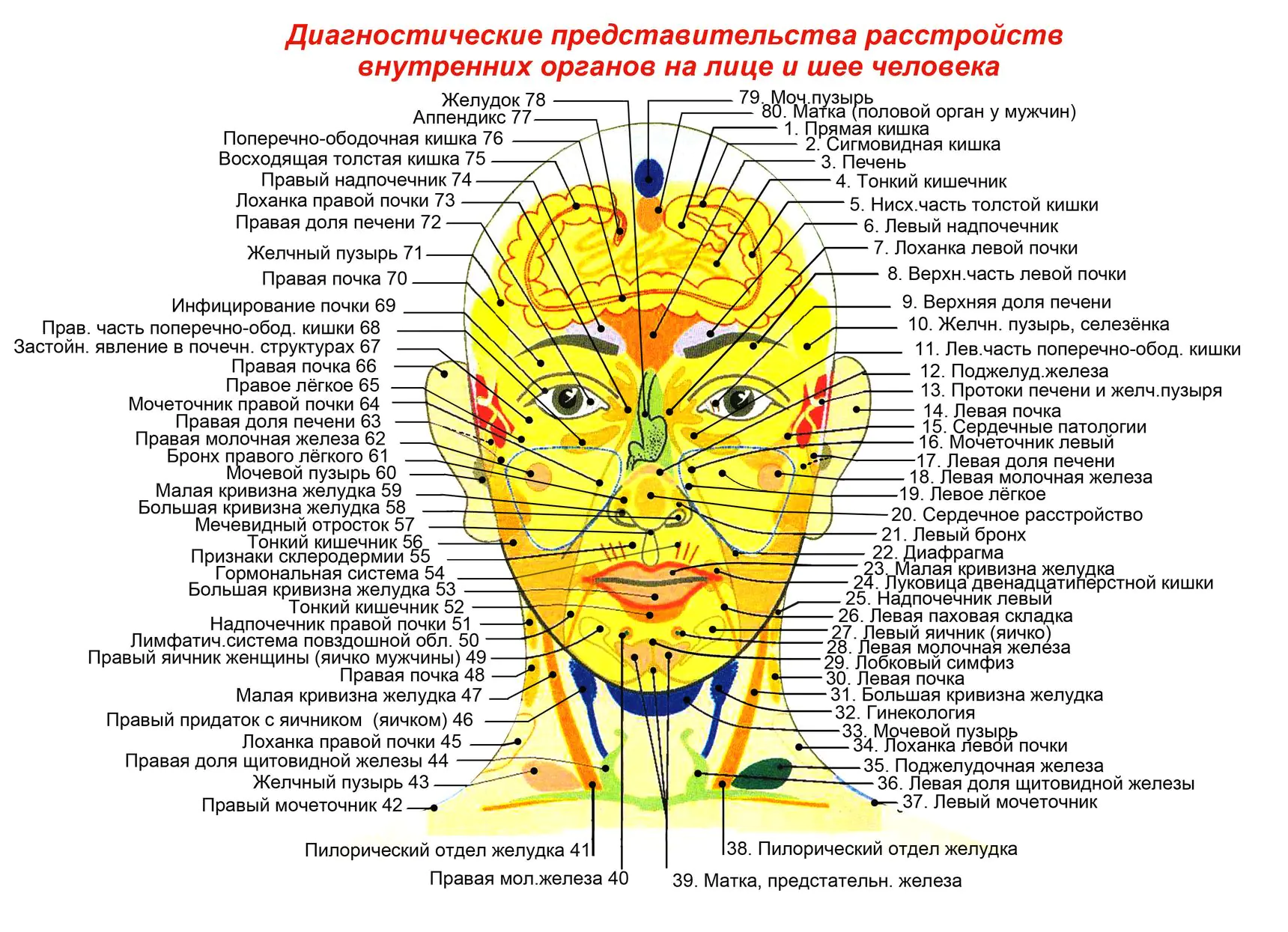
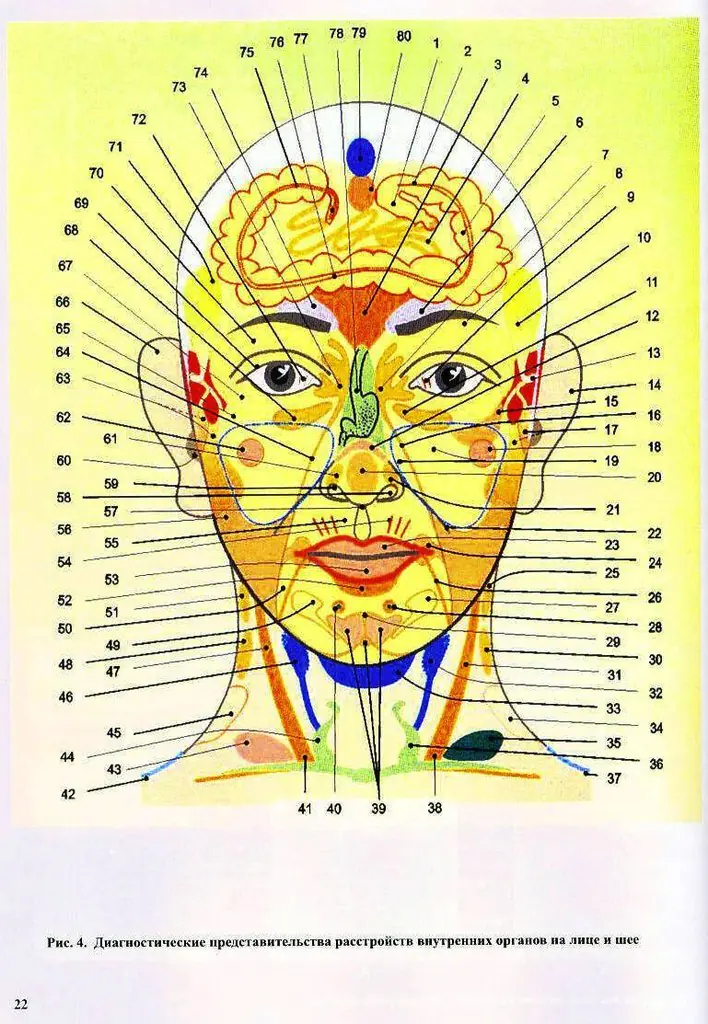
uduba.com



